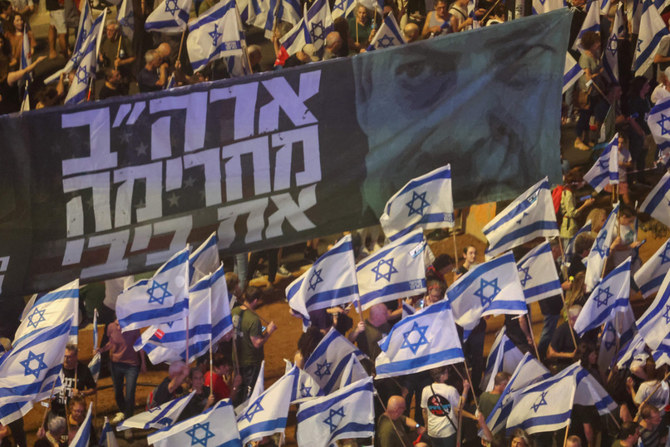Yossi Mekelberg
Israel is no stranger to mass protests. At many major junctures in the country’s history, people have taken to the streets to voice their concerns. In the late 1970s, for instance, many thousands filled the streets to encourage their government to make progress in the peace negotiations with Egypt. A few years later, in 1982 – in what is still the largest demonstration in the country’s history – protesters demanded a judicial inquest into Israel’s role in the massacre of Palestinian refugees in Sabra and the Shatila camp in Beirut.
However, as crucial as these mass rallies were, they concentrated on a single issue, they took place over a short period of time, they mainly took place in the more liberal-oriented Tel Aviv and you could not mistake the political-ideological persuasion of those participating.
But what we have seen over the past six months of almost daily protests against the current government’s antidemocratic drive, through legislation and other means, is a completely new phenomenon in terms of intensity, methods, organization and perseverance. It may well go on to become a model for others to emulate – a model of civil resistance to governments that are moving away from democracy toward a quasi-authoritarian system of governance. However, it remains unclear for how long the protest movement can sustain this standoff with the government and continue to motivate masses of people to keep on actively protesting. On the one hand, the mass demonstrations that began in early January of this year were a spontaneous and direct response to a series of antidemocratic pieces of legislation brought in by the new coalition government. Both the speed and the magnitude of the assault on good governance, on integrity in public life and, above all, on the judiciary provoked the pro-democracy forces in Israel to organize themselves, quickly and with a sense of purpose.
On the other hand, much of what has emerged in the last few months is an accumulation of malaise in large parts of Israeli society, which fear for the democratic system but are also resentful that their dwindling influence on the direction the country is taking is in inverse correlation to the contributions they make to Israel’s prosperity and security. Meanwhile, those who barely pull their weight are now in power and using antidemocratic methods in their attempts to perpetuate their rule. Impressively and organically, an authentic leadership of this protest movement has emerged and, with it, the exemplary organizational skills required to continue to hold the countrywide mass rallies. But these leaders also have day jobs and by no stretch of the imagination do they represent a monolithic movement with a single and coherent political agenda. This is both the movement’s strength and its weakness. It is mainly a coalition of movements and individuals that has set itself to contain and, if possible, reverse the government’s moves to seize all power and, in the process, trample on and crush the checks and balances system without which no true democracy can survive.
But whereas there are still substantial numbers turning out to make their voices heard, particularly at the major demonstrations in Tel Aviv’s Kaplan Street, numbers are declining and it is a huge challenge for the organizers to consolidate this support every weekend. At the same time, however, the very proactive “Black Flag” movement, for example, which throughout the week “meets and greets” ministers and other MKs who are members of the coalition wherever they go, with chants such as “democracy” or “shame,” is continuing its activities all across the country and on social media with high levels of determination, sophistication and efficiency. Admittedly, sustaining this level of support for so long is extremely impressive, especially in the face of the authorities’ state power and resources. However, if initially Prime Minister Benjamin Netanyahu was taken by complete surprise at the resistance to his unscrupulous and irresponsible maneuvering, and seemed to lose both his cool and his judgment, he is now back to his old opportunistic “best” in manipulating the entire political system. This presents a tough challenge to those who head the protest movement as they seek to convince people that they may have won a battle or two but are very far from winning the war.
For now, much of the antidemocratic legislation is on hold, while negotiations between representatives of the coalition and the opposition are being hosted by the president, but both sides know that, at present, there is no compromise in sight. This serves Netanyahu as best as it can under the circumstances and it also sedates the protests against his government. Undeniably, when it comes to mass protests, the number of feet on the ground is key, but it was only to be expected that the initial fever would subside somewhat. Yet a smaller protest movement, but one more united behind its message, could actually bolster it and increase its impact. Such a movement could look beyond the current crisis and the business of containing this government and begin to build a progressive-democratic agenda that is fit for the 21st century and will be able to guarantee that the democratic system cannot be harmed by the occasional election result.
Now that cracks are beginning to show in the Netanyahu government, there is an opportunity for the protest movement to galvanize its leadership, its cadres and, most importantly, its objectives. Furthermore, there are opportunities for the segments of Israeli society that are natural allies of the protest movement – such as the Palestinian citizens of Israel, who do not feel that their plight is currently being aired by the protests, or those on the periphery who have been neglected by the government but traditionally support the right – to be brought into the fold. Reaching out and including these populations could strengthen the protesters’ cause and give them additional legitimacy. Israel’s protest movement can look back on the last six months with great satisfaction and pride. It has built an apolitical front that has, at least for now, slowed down the attacks on the country’s democratic system and driven a wedge between those in the government who are ready to charge on with their irreversible harms against the judiciary regardless of the public response and those who realize that, even if they support such moves, it could all end in an electoral disaster for them.
The danger now is that Netanyahu and some of his allies might revert to delaying and salami tactics – incremental moves that, when combined, are as dangerous yet not as obvious and, as a result, will make it harder to encourage people to take to the streets. And this is where the leaders of the protest movement are going to be further tested. Hopefully they will show their mettle, as they have done so impressively over the last 24 weeks.







